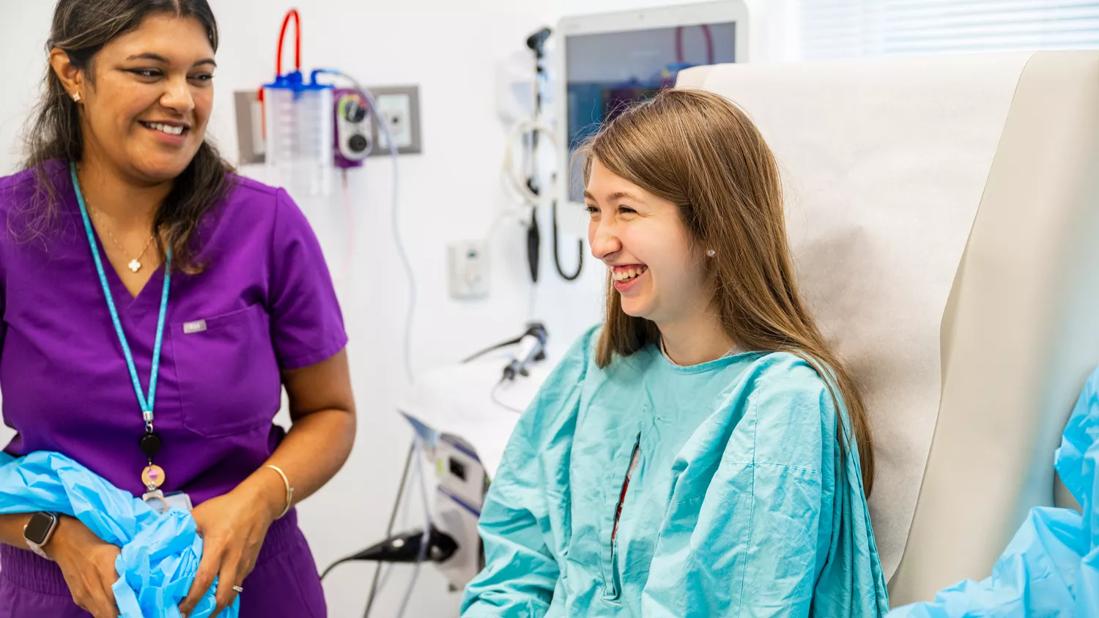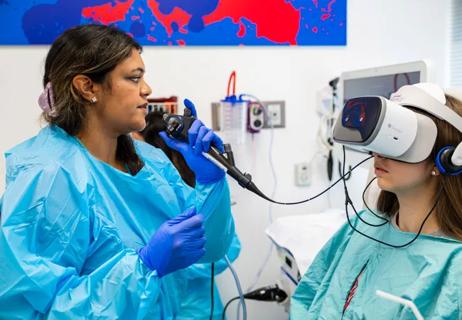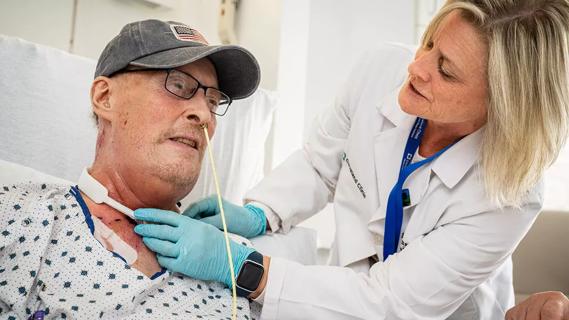Pediatric and adult gastroenterologists offer team care for patients with eosinophilic esophagitis

The transition from pediatric to adult healthcare is critical for continuity of care, yet only 15% of youth with or without special healthcare needs receive transition assistance from providers, according to the American Academy of Pediatrics. Cleveland Clinic is committed to pediatric-to-adult care transition for all patients.
Advertisement
Cleveland Clinic is a non-profit academic medical center. Advertising on our site helps support our mission. We do not endorse non-Cleveland Clinic products or services. Policy
In August 2021, two gastroenterologists launched a dedicated clinic to transition patients with eosinophilic esophagitis (EoE), an inflammation of the esophagus characterized by an overabundance of certain white blood cells. It is often triggered by food or environmental allergens. Symptoms of the chronic condition include heartburn, regurgitation, chest pain and trouble swallowing. For young children, it may present as failure to thrive or being a “picky eater.”
“The goal of the EoE Transition Clinic is to smoothly bring patients who are accustomed to the pediatric setting over to the adult setting, while making sure there are no delays in care,” says gastroenterologist Claire Beveridge, MD, who leads Cleveland Clinic’s EoE adult clinic. “We make sure that there is good communication and hand-off between everyone involved.”
Dr. Beveridge heads the EoE Transition Clinic with pediatric gastroenterologist Sophia Patel, MD. Dr. Patel also leads a multidisciplinary EoE clinic for pediatric patients alongside an allergist, dietitian and care coordinator.
“We are fortunate at Cleveland Clinic to have both adult and pediatric GI specialists, so our EoE patients can go to one place and meet both at the same time,” says Dr. Patel. “That’s not something a lot of healthcare systems offer.”
Drs. Beveridge and Patel hold the EoE Transition Clinic about twice a year, but sometimes more often depending on patient needs. They have successfully transitioned nine patients and have a few patients scheduled for the next clinic.
Advertisement
Patients with EoE are a “small but growing population,” says Dr. Patel, citing prevalence of about 1 in 2,000 people. Patient care can be complex, involving multiple endoscopies per year while trying to get the condition under control. This can involve medication changes or food elimination.
“Most of our patients have had EoE since they were very young, so by the time they are 18, 19, 20 years old they have been living with the disease for more than a decade,” she says. “They have a long patient history that can get lost in the move from pediatric to adult care.”
One of the main goals of the transition clinic is to share the patient’s complete history. During the 45-minute appointment, Dr. Patel typically meets first with the patient to discuss their current regimen, symptoms, eating habits, medications and whether EoE is interfering with their daily activities. Then, she leaves the room and consults with Dr. Beveridge about the patient’s history, treatment plans, upcoming tests and pertinent test results.
Next, both physicians enter the room together, where Dr. Beveridge describes adult gastroenterology to the patient and answers questions about transitioning to adult care. If the patient is comfortable at the end of the visit, a scheduler will contact them to plan their next appointment with adult gastroenterology.
There is no set age for transitioning patients with EoE. Drs. Patel and Beveridge usually consider patients who are age 18-21 and feel comfortable with the move to adult care.
Advertisement
“Many young adults are already managing college, jobs and apartments without much involvement from their family,” says Dr. Patel. “Those patients who are coming to pediatric appointments on their own, making their own appointments and answering MyChart messages themselves are ready to transition.”
That transition is made easier when gastroenterologists are aligned in patient care.
“Dr. Patel and I have similar ways in which we manage EoE patients — how we counsel them, what kinds of treatments we offer, what we do in terms of endoscopies,” says Dr. Beveridge. “That reassures patients that things will feel the same when they come to the adult side — just without the pretty unicorn pictures outside the clinic rooms!”
Patients in both pediatric and adult clinics have access to the latest treatments for EoE, including the monoclonal antibody dupilumab. The medication received initial FDA approval in 2022 for patients age 12 and older and was approved in January 2024 for patients ages 1 to 11.
The team also uses the endoluminal functional lumen imaging probe (EndoFLIP™), a relatively new balloon-based technique that is performed under sedation alongside a traditional sedated endoscopy. It helps determine esophageal motility and distensibility and identify any narrowing that may need to be stretched. The procedure, which is used for various swallowing disorders, can generate more information about the patient’s EoE disease process.
“Any gastroenterologist will probably see dysphasia or swallowing issues, but having expertise in EoE on both the pediatric and adult side is a rarity,” says Dr. Patel. “Our patients get really great care, and when it’s time to transition, they get two experts looking at their chart and considering all the options for treatment and long-term monitoring.”
Advertisement
Advertisement

25-year series of over 1,000 patients reveals good long-term palliation, esophageal preservation

Case highlights the benefits of a minimally invasive approach

Potential for new, non-invasive screening option

3 pediatric gastroenterologists discuss advances in their diagnostic toolkits

Going beyond the Eckardt symptom score to evaluate dyspepsia, eating and symptom “bother”

Modified Barium Swallow Study and Flexible Endoscopic Evaluation of Swallowing can both be used to diagnose dysphagia, but it’s important to understand their advantages and disadvantages

Long-acting antiemetics and high-dose steroids key to minimizing acute nausea

Research could help direct care pathways for patients with unexplained swallowing difficulties